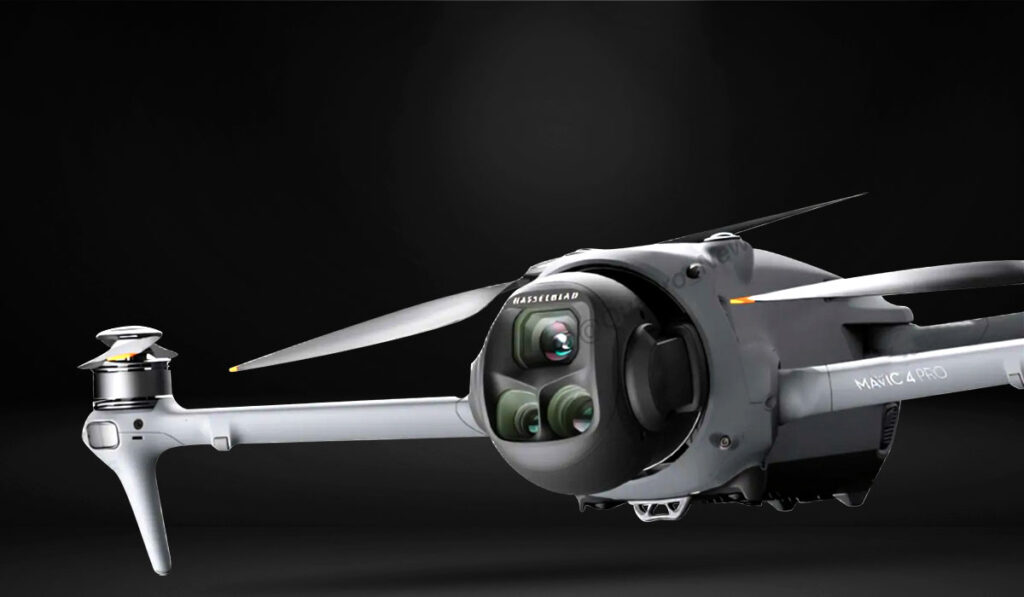DJI enthusiasts are eagerly awaiting the launch of the DJI Mavic 4 Pro, a drone that promises to elevate aerial photography to new heights. With the success of its predecessors, the Mavic 4 Pro is set to redefine what’s possible in consumer drones. Over the years, DJI has led the drone industry with its innovative technology, and each new release raises expectations even higher. The upcoming Mavic 4 Pro is no exception, stirring excitement among professionals and hobbyists alike.
Building upon the legacy of the Mavic 3 series, the Mavic 4 Pro is rumored to introduce significant upgrades in camera technology, battery life, and user experience. These improvements suggest that DJI is focused on creating not just a better drone, but a more powerful tool for creative expression and professional work.
In this post, we’ll delve into the anticipated features of the Mavic 4 Pro, compare it with its predecessor, and explore how it stacks up against competitors in the flagship drone market.
Today’s Best DJI Mavic 4 Pro Amazon Deal

Mason knows photography inside and out. With 15 years of hands-on experience, he’s written about cameras, lenses, and gear of all kinds. He even spent five years as a journalist, diving deep into music and writing sharp, engaging stories. Now, Mason shares his photography knowledge, helping readers find the right gear and perfect their skills. He’s also proud of his unbeatable Wordle streak!
Expected Features of the DJI Mavic 4 Pro
Triple-Camera System
The Mavic 4 Pro is expected to feature a triple-camera system comprising three different focal lengths: a 28 millimeter wide lens, a 70 millimeter medium telephoto lens, and a 168 millimeter telephoto lens. This setup is designed to give users a wide range of perspectives straight out of the box, helping photographers and filmmakers capture everything from wide landscapes to detailed close-ups without needing to switch drones or accessories.
Leaks suggest that the wide lens will use a large 4/3-inch CMOS sensor. This type of sensor is known for excellent low-light performance and better dynamic range. It captures more light and detail, making it suitable for both daylight and twilight conditions.
For users, this new camera system means more creative control. You can switch between different focal lengths easily during flight, allowing you to tell stories visually in more dynamic ways. Whether you’re shooting real estate, nature documentaries, or social media content, this flexibility opens up new possibilities.
Enhanced Battery Life and Charging
Battery life is often one of the biggest concerns for drone users. The Mavic 4 Pro addresses this by possibly including a 95 watt-hour battery. This upgrade could offer up to 52 minutes of flight time per charge, making it one of the longest-lasting consumer drones on the market. Compared to many existing models, this is a major improvement and would allow for longer shooting sessions without interruptions.
Charging also seems to be getting a significant upgrade. Reports mention a 240-watt fast charger that could charge three batteries in just 90 minutes. For users who are on tight schedules or working on location, this faster charging capability is a huge advantage.
For professionals who rely on drones for commercial projects, having more time in the air and less time spent waiting on battery charges will improve efficiency and reduce downtime. It will also help casual users enjoy longer flights without constantly checking battery levels.
DJI RC Pro 2 Controller
Another major update expected with the Mavic 4 Pro is the new DJI RC Pro 2 controller. This controller is rumored to include a 7-inch extendable touchscreen, which would provide a larger, clearer view of your flight and footage. A full-sized HDMI output may also be part of the design, allowing for live streaming or external monitor use.
In addition, a new scroll wheel is said to be added for better manual control over camera functions. These changes aim to create a smoother and more user-friendly flying experience.
With these enhancements, pilots can expect greater control and visibility even in bright sunlight or challenging conditions. More ports and a better screen make it easier to monitor footage in real-time, share content quickly, and adjust settings without fuss.
LiDAR Integration
Perhaps one of the most exciting rumors is the potential addition of a LiDAR system. LiDAR, or Light Detection and Ranging, allows the drone to sense and map its environment with extreme precision. If this feature is included, it would mark a huge leap in obstacle avoidance and spatial awareness.
This technology could help the Mavic 4 Pro fly more safely and accurately, especially in complex or cluttered environments. It would also be a valuable tool for industries like surveying, construction, and 3D modeling.
For users who need detailed environmental data or fly in challenging areas, LiDAR would provide an extra layer of safety and functionality. It shows that DJI is not just focusing on visual capture, but also on expanding the drone’s real-world applications.
Design and Build
In terms of physical design, the Mavic 4 Pro is expected to be slightly larger and heavier than its predecessor. This change likely accommodates the bigger battery, triple-camera system, and possible LiDAR sensor. While this might reduce the drone’s portability slightly, the trade-off is a more capable and durable piece of equipment.
The new design may also include improvements in aerodynamics and quieter propellers, inspired by the Mini 4 Pro. These tweaks can help the drone fly more efficiently and with less noise, which is especially useful in sensitive environments like weddings or wildlife areas.
Overall, while the design may shift a bit in size and weight, the added performance and stability are expected to make it well worth it for most users.
DJI Mavic 4 Pro vs Mavic 3 Pro: Key Differences
When comparing the upcoming Mavic 4 Pro to the Mavic 3 Pro, several key differences stand out. One of the most obvious is the camera system. While the Mavic 3 Pro featured a dual-camera setup, the Mavic 4 Pro is expected to add a third lens. This triple-camera arrangement will provide more focal lengths and better coverage for different types of shots. It represents a clear upgrade in terms of creative flexibility and image quality.
Battery life is another area where the Mavic 4 Pro looks to outperform its predecessor. The larger 95 watt-hour battery could offer up to 52 minutes of flight time, significantly more than what the Mavic 3 Pro could provide. This is especially important for professional users who need longer airtime for projects.
The controller is also set for a major upgrade. The Mavic 3 Pro came with a standard controller, but the Mavic 4 Pro may include the new DJI RC Pro 2. With a larger screen, HDMI output, and improved controls, the flying experience will be more advanced and user-friendly.
Finally, the price point will reflect these upgrades. While the Mavic 3 Pro had a premium price, the Mavic 4 Pro is expected to cost more due to its improved hardware and new features. However, for many users, the added capabilities will justify the higher cost.
Competitors in the Flagship Drone Market
Autel EVO II Pro
The Autel EVO II Pro is one of the strongest competitors in the high-end drone market. It features a 1-inch sensor and supports 8K video recording, making it an appealing choice for users who value high resolution. However, it lacks the versatility offered by a multi-lens system like the one expected in the Mavic 4 Pro.
While the EVO II Pro excels in raw video resolution, the Mavic 4 Pro’s triple-camera system is likely to offer greater creative flexibility. Users will be able to switch focal lengths in mid-flight, something not possible with the EVO II Pro. Additionally, if the Mavic 4 Pro includes LiDAR, it will have a significant advantage in obstacle detection and advanced mapping.
Skydio 2
The Skydio 2 stands out for its autonomous flying capabilities and robust obstacle avoidance. It uses AI to navigate complex environments with minimal user input, making it a favorite among action sports filmmakers and explorers.
However, the Mavic 4 Pro may offer a different value. With its high-end camera system, extended flight time, and potential LiDAR integration, it is expected to cater more to professional photographers and videographers who require fine image control rather than full autonomy.
Release Date and Pricing
The DJI Mavic 4 Pro is rumored to be released on May 13, 2025, following a teaser announcement that was initially expected around April 17, 2025. Although earlier leaks pointed to an April 24 release, recent updates based on internal DJI communications confirm the revised launch timeline.
As for pricing, leaked information suggests a tiered structure. The base model, which includes the DJI RC2 controller, is expected to retail for around $2,250. The Fly More Combo, which includes extra batteries and accessories, may be priced around $3,200. For content creators and professionals, the Creator Combo, featuring the DJI RC Pro 2 controller and 512 gigabytes of internal storage, is expected to cost about $4,400.
These prices reflect the Mavic 4 Pro’s positioning as a high-end flagship drone designed to meet professional demands.
What are the main features of the DJI Mavic 4 Pro?
When will the DJI Mavic 4 Pro be released?
How does the Mavic 4 Pro compare to the Mavic 3 Pro?
What is LiDAR, and will the Mavic 4 Pro have it?
How much will the DJI Mavic 4 Pro cost?
Conclusion
The DJI Mavic 4 Pro could be an interesting addition to DJI’s lineup. From a powerful triple-camera system to longer flight times and advanced features like LiDAR, this drone is expected to raise the bar for what is possible in aerial imaging. This drone is expected to cater to professional photographers, filmmakers, and drone enthusiasts seeking advanced features and enhanced performance. If the rumors hold true, the Mavic 4 Pro will not only surpass the Mavic 3 Pro but also pose a strong challenge to its competitors.
Stay tuned to MyLensLogic.com for the latest updates on the DJI Mavic 4 Pro, including official announcements, detailed reviews, and comparisons with other top-tier drones.


